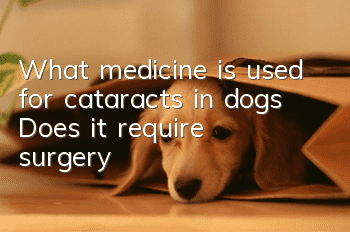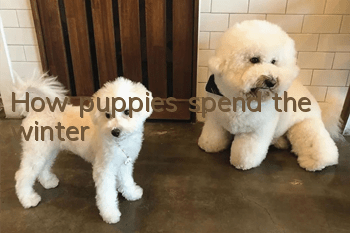What medicine is used for cataracts in dogs? Does it require surgery?

The so-called cataract is actually the opacity of the lens and lens capsule. The lens in the normal eye is transparent and colorless. If turbidity occurs, it will appear white and opaque. For dogs and cats, cataracts are one of the most common diseases that can lead to visual impairment or even blindness. It occurs in both mixed-breed and purebred dogs, and this disease affects the behavior and visual function of dogs and cats. Significant negative impact.
1. The causes of cataracts in dogs and cats: Congenital and hereditary: Some cataracts are congenital or hereditary, so when choosing animals, try to avoid young animals with congenital cataracts. Senile: It is common for the lenses of middle-aged and elderly animals to develop cloudy lesions due to aging. Secondary: Cataracts are often secondary to other eye diseases, such as eye trauma, uveitis, lens dislocation, retinal disease, etc.
2. Clinical symptoms of cataracts in dogs and cats: white areas can be seen in the pupils, the sick animals have visual impairment or even blindness, they bump into furniture or things when walking, and their flexibility of movement is reduced.
3. Methods for detecting and confirming cataracts in dogs and cats: The animals should be taken to a hospital with ophthalmic experience and equipment. The doctor will carefully use ophthalmic instruments to examine the entire eye. In addition to the degree of lens disease, retinal function must also be checked. Mature cataracts may cause secondary uveitis, which often reduces the success rate of surgical treatment.
4. Treatment of cataracts in dogs and cats: Currently, all veterinary ophthalmologists in the world unanimously recommend that surgical removal of cataracts is the only reliable treatment. There is no effective treatment for cataracts in dogs and cats. Currently, the most advanced surgical treatment method is small incision phacoemulsification combined with intraocular lens implantation, with a success rate of over 80%. The success rate depends on the severity of the cataract, the presence of complications, and the overall health of the dog. Cataract surgery is pointless if the retina is dysfunctional and cannot conduct vision. Cataract surgery in dogs and cats is a precision microscopic eye surgery. Therefore, the surgery must be performed in a hospital with suitable and complete surgical equipment.
The treatment methods for cataracts in dogs vary according to different causes and ages. Generally speaking, they are mainly divided into two types: medical therapy (mainly using eye drops to prevent its deterioration) and surgical therapy (surgery to remove fibrotic lens). However, the causes of cataracts are quite complex and relatively difficult to treat, and the recovery is usually very satisfactory. When the cataract develops for a certain period of time, the white film may liquefy and fall off. At this time, the animal can recover part of its vision.
However, the peeling film may also irritate the eyes and cause inflammation. This kind of disease in dogs will not heal on its own. It needs to be treated in the hospital, but it is very expensive. You can go to the hospital and ask! Of course, surgical treatment is definitely the most immediate, and there will be no recurrence after surgery. If you notice any abnormalities in your pet's eyes or vision, you should seek medical attention as soon as possible.Since pets are "not good at talking", any physical discomfort depends on the parents' discovery. You know, the structure of the dog's eyes is very precise, and professional ophthalmologists will use professional instruments and techniques to diagnose the condition.
We usually see many cases in the outpatient clinic that take a long time to come to see a doctor. Through consultation, we learned that in fact, the family has long known that there are some problems with the pet’s eyes or vision, but they just do not pay attention to it, causing the condition to worsen and missing the golden treatment. During this period, delaying medical treatment sometimes not only worsens vision, but may even cause loss of eyeballs. Therefore, if family members notice abnormalities in the eyes or vision of animals, they must seek medical advice as soon as possible. Do not blindly apply eye drops. The causes and applicable eye drops for pet eye diseases are different from those of human eye diseases. Parents are reminded not to use human eye drops without the consent of an ophthalmologist. If used incorrectly, it can often aggravate the condition. Also, clean the eyes frequently. If a pet's eyes are infected, the biggest headache for parents is the large amount of eye secretions. It is very important to keep the eyes clean. Parents can usually go to the pharmacy to buy physiological saline to rinse the eyes, flush the secretions out of the eyes and wipe them away.
If there is excessive eye secretion or serious infection, you should go to the hospital for examination as soon as possible. In addition, before instilling eye drops, you should rinse away eye secretions before instilling eye drops, so that the efficacy of the medicine can be fully exerted. Prevent excessive exposure to sunlight or ultraviolet rays. Medical science has confirmed that ultraviolet rays are harmful to the eyes, both to humans and animals. Different wavelengths of light in the sun will be absorbed by the various structures of the pet's eyes (lens/cornea/retina). Excessive exposure to ultraviolet rays may lead to the aggravation of certain diseases, such as the worsening of cataracts and the decline of retinal function. .
Therefore, if your pet’s eyes have certain pre-existing diseases, you should try to avoid receiving too much sunlight or ultraviolet rays, and also avoid contact with dust, sand, and polluted exhaust gases. At present, there are already sunglasses specially designed for dogs in foreign countries, but this condition may not be available in China. However, I believe that with the development of my country's pet industry, this gap will be filled sooner or later.
Next, let me tell you which dogs are suitable for surgery:
1. Cataract surgery in animals is different from that in humans. Compared with animals, cataract surgery is not a minor surgery and requires general anesthesia.
2. Cataract surgery requires one to two months of post-operative care and treatment. Therefore, parents who cannot cooperate with the treatment are not recommended to allow their dogs to undergo cataract surgery.
3. Dogs that are overly sensitive, nervous, and aggressive are not suitable for surgery.
4. Severe systemic diseases or infections, cardiopulmonary dysfunction, etc. are not suitable for surgery and general anesthesia. Surgery is not recommended for patients with obvious abnormal visual reflexes and other eye diseases (such as infection, dry eye, glaucoma, etc.).
5. In addition to evaluating cataract lesions, doctors will evaluate the animal's visual reflex function and whether there are obvious complications. Dogs suffering from hereditary retinal diseases and retinal detachments are not suitable for surgery.
6. "Electroretinogram" is a standard examination item before cataract surgery to confirm whether the dog suffers from common hereditary retinal diseases or reduced retinal function. If the retinal potential map is abnormal, it means that the nerve function of the retina has been impaired, so there is no need for further surgery. Proper case selection is very important to the success rate of cataract surgery. First, a thorough history and physical examination of the animal should be performed to determine, for example, whether the animal has diabetes, liver or kidney disease that would affect anesthesia, or blepharitis. Second, give the animal a thorough eye exam. The temperament of the animal will also affect the success rate of cataract surgery. If the animal is too sensitive, reasonable eye medication cannot be administered after surgery. Therefore, for those dogs that are obviously aggressive, the success rate of surgery may be reduced. Animals should undergo a detailed ophthalmic examination before cataract surgery, including: measurement of tear volume, examination of ocular adnexa, threat test, direct and indirect pupillary reflexes, and measurement of intraocular pressure. If these examination items are normal, a dilated fundus examination should be performed. The cornea is inspected for opaque areas that may interfere with intraocular operations. In addition, if there is edema in the cornea before surgery, it means that the corneal endothelium may have decompensated. At this time, the degree of corneal edema may be more serious after surgery. Check the iris for excessive pigmentation, iris synechiae, and uveal ectropion caused by LIU. Check the anterior chamber for aqueous flare and retrocorneal deposits. In addition, electroretinogram examination of the affected eye should also be carried out. This is very important because if the dog's retinal function has been lost, the affected eye will not be able to recover vision even after cataract surgery, and this problem is not clinically relevant. Not uncommon. Only dogs whose examination items are completely normal can undergo surgery.
Learn to take care of elderly dogs:
First, talk to it every day. It will be in a good mood and feel that you, the owner, do not dislike it;
Second, go to a pharmacy, not a veterinary pharmacy. Buy the intravenous solution and chloramphenicol eye drops used by that person to give him a cross point;
Third, pay attention to its eye hygiene and kennel hygiene;
Fourth, buy some anti-inflammatory medicine and give it to it. It will usually be cured within a week. Don’t worry. After it is cured, buy some vitamins and calcium tablets for it, and change them every day. Dogs are our friends, so take good care of them.
Recommended Good Things
Aineng Pet Deodorizing Disinfectant, effectively removeBody odor/stool odorand other odor molecules! Effective in treating skin diseases caused by fungi/bacteria! Can kill parvovirus/canine distemper virus/coronavirusetc!
It is edible grade for pets, does not contain fragrances, does not contain chemicals, can be sprayed directly, and is harmless to human pets!
Consultation: 13028809308 (WeChat synchronization)
Scan the QR code on WeChat to enter the purchase
- Teddy dog training methods and techniques will teach you how to train an obedient dog!
- Is the jelly-like poop in a Teddy dog a sign of enteritis? Don’t ignore it!
- Four reasons why dogs have serious tear stains
- Four Human Foods You Can Give Your Dogs
- How do you usually take care of your dog’s teeth?
- Will having a dog lick people transmit parasites?
- How to raise Chow Chow puppies, how to raise Chow Chow puppies
- The puppy keeps whining
- The reason why dog vaccination fails is revealed, owners should not panic!
- Why do dogs get arthritis?



